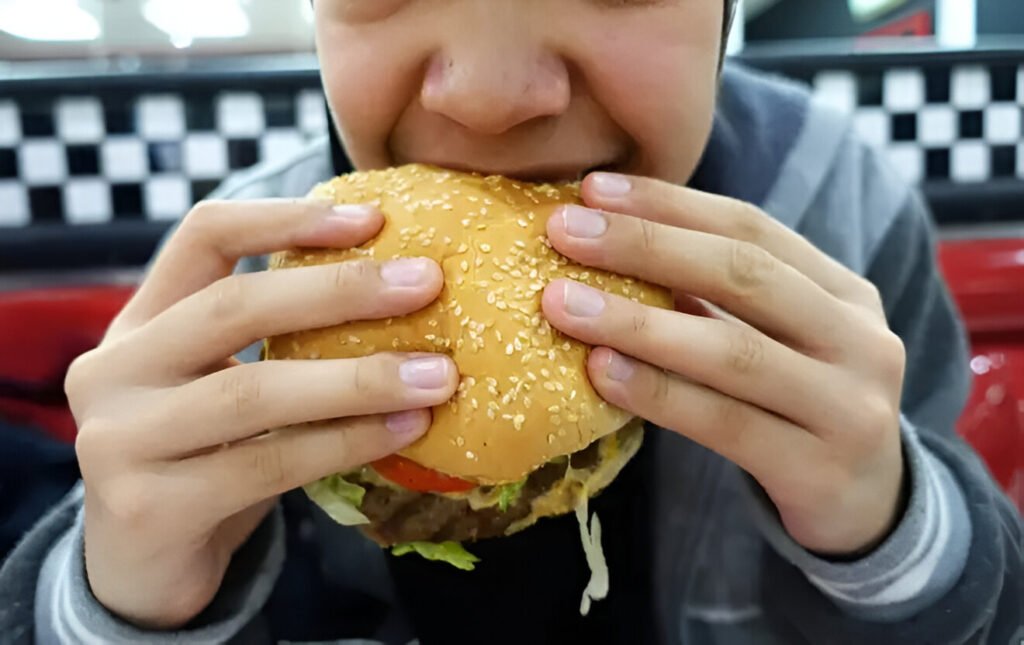
Kids are like little sponges absorbing everything they see, hear, and scroll past. And when it comes to junk food advertising, they soak that up too and fast. A new study has confirmed what many parents have long suspected: it takes just five minutes of junk food advertising to influence children’s eating habits significantly. And here’s the surprising part: it doesn’t even need to show actual food.
According to research presented at the European Congress on Obesity, even brand-only advertisements—those that feature just logos, catchy jingles, or fun taglines—can cause children to consume an average of 130 extra calories per day. That’s about the size of a small chocolate bar, a bag of chips, or a serving of cookies each and every day just from viewing a few well-designed ads.
The Subtle Power of Branding
What’s so effective about these commercials? It’s not the eye appeal of a goofy burger or soda; it’s the emotional hooks. The upbeat music, bright colors, popular cartoon characters, and cheerful settings produce positive associations in a child’s mind. Even when children aren’t hungry in the physical sense, these commercials can implant the idea that they’re in the mood for a snack.
Kids aged 7 to 15 are particularly at risk. They are at this stage still learning to think critically and so might not realize that advertising is meant to manipulate them. Instead, they watch an amusing short, and their brain associates it with happiness. That association can influence them subconsciously to eat high-calorie, low-nutrient foods.
Professor Emma Boyland, the lead researcher, summed it up perfectly: short bursts of exposure to high-fat, salty, and sugary food advertisements can prompt children to eat more. It’s not about when or where the ad appears; it’s about the emotional imprint it leaves.
Ads Are Everywhere—And Kids Are Watching
This isn’t just about traditional TV anymore. Junk food ads have found their way into every corner of a child’s digital life, from YouTube videos and Instagram reels to mobile games and bus stop posters. If it’s a screen or a public area, chances are it’s hosting some type of junk food promotion.
This repeated exposure accumulates. Children aren’t simply passively watching programming; they’re being gently pushed again and again to want and eat unhealthy snacks. And eventually, those additional 130 calories a day can create a substantial calorie surplus and weight gain.
Childhood Obesity: An Emerging Crisis
Let’s take a step back for a moment. Obesity in children isn’t merely an aesthetic issue; it’s a full-blown public health crisis. More children today are gaining excess weight due to a combination of sedentary lifestyles, poor diet choices, and the relentless push of unhealthy food marketing.
This excess weight brings with it a host of physical health problems like high blood pressure, type 2 diabetes, and joint issues. These were once considered adult conditions but are now appearing in children as young as elementary school age. On top of that, the emotional toll can be just as heavy: low self-esteem, bullying, body image issues, and even depression.

And here’s the most heartbreaking part: it’s not entirely the kids’ fault. They’re growing up in a world that constantly markets unhealthy choices to them. From school cafeteria menus to the ads they see on their favorite gaming apps, the odds are stacked against them.
So, what can we do?
The good news? There are ways to push back. While some governments are taking action, like the UK’s initiative to ban junk food ads before 9 PM, real change requires collective effort. Parents, schools, communities, advertisers, and even tech platforms all have a role to play.
Here are a few practical steps we can take:
1. Parental Involvement:
Parents can take an active role in monitoring what their children watch and engage with. Reducing screen time, offering more home-cooked meals, and encouraging outdoor play are small but impactful changes.
2. Healthier School Environments:
Schools can revamp their lunch programs to include more nutritious options and teach kids about healthy eating habits in engaging, age-appropriate ways.
3. Active Communities:
Local governments and communities can support parks, playgrounds, and sports clubs, creating spaces where children can be active and social, away from screens and snack ads.
4. Responsible Advertising:
Advertisers and digital platforms can be encouraged or regulated to limit marketing of high-fat, sugary, and salty products to children. Promoting healthier food options with the same level of creativity could shift norms in a more positive direction.
Shaping a Healthier Future
This isn’t about blaming children or making them feel guilty about what they eat. It’s about creating an environment where the healthier choice becomes the easier, more accessible one. It’s about helping them build a strong foundation for a lifetime of well-being physically, emotionally, and mentally.
Fewer ads for soda, more encouragement for fruits and veggies. Less couch time, more bike rides. It’s a cultural shift, and it starts with us, the adults in the room, being more aware, more intentional, and more committed to our kids’ future.
Because at the end of the day, healthy kids don’t just mean happier homes; they mean a healthier world.









